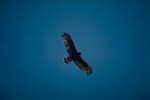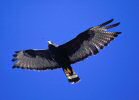Mangoverde :: World Bird Guide :: Hawks, Eagles and Kites :: Zone-tailed Hawk
Zone-tailed Hawk Buteo albonotatus
Described by: Kaup (1847)
Alternate common name(s): None known by website authors
Old scientific name(s): None known by website authors
Photographs



Select thumbnail to view larger image - Place cursor over image for image information
Range
Sw. United States through Central America; N. South America; Nw. South America; E. to sc. South America;
Fragmented (incompletely known) distribution;
Sw. United States (s. California, s. Arizona, s. New Mexico and w. Texas), nw. and nc. Mexico (n. Baja) s. through Guatemala to Panama (Pearl Is.) and into South America forming a broken ring around the Amazon Basin from n. Colombia (Santa Marta Mountains to Magdalena and e. of the Andes in Meta, Caqueta and Amazonas) e. through n. and se. Venezuela (Zulia to Anzoategui and ne. Bolivar), Trinidad, Guyana, Surinam, Guiana, and w. in w. Ecuador and cw. Peru (Lima) and s. from the Amazon Delta in n., e. and se. Brazil (I. de Marajo, Ceara, Pernambuco, Alagoas and Bahia (Chapada Diamantina, Ilheus) to Parana), then w. through Paraguay to n. and e. Bolivia (Beni and Santa Cruz).
N. populations winters to the s.
___________________________________________________________________________________
North America n. of Mexican border
Summer: nw. ARZ, nc. NMX, sc. TEX (Big Bend);
Winter: a few bird remain in n. range over the winter;
Videos
No videos are available for this species
Sounds
No sounds are available for this species
References
Clements, James F. Birds of the World: A Checklist. Vista, CA: Ibis Publishing Company, 2000.
Comments/Errors
Please email with errors/comments on this page or to donate photos.
If there is no family list to the left, you may have arrived at this page from a direct link.
Please select "Mangoverde World Bird Guide" to view the entire bird site.





